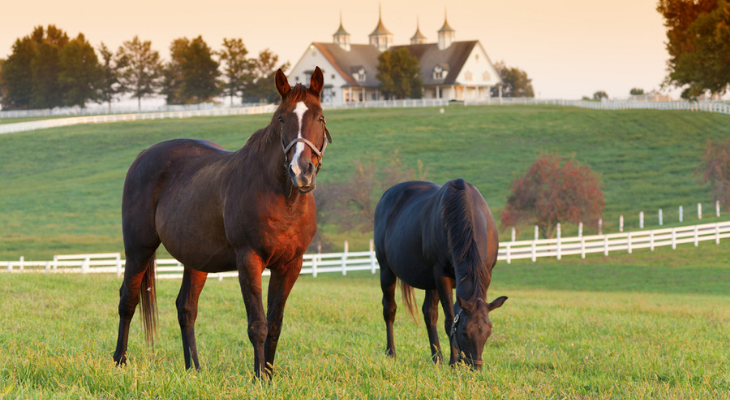
Turnout Is Essential for Your Horse's Health and Well-Being
How much time does your horse spend outdoors? Without adequate turnout time, your horse's health could suffer.
How Turnout Helps Your Horse Stay Happy and Healthy
Increasing turnout time can offer these benefits:
- Improved Digestion: Left to their own devices, horses prefer to eat small amounts during the day. In fact, their small stomach size makes grazing the ideal way to eat. When horses are constantly on the move, food passes through their gastrointestinal systems much more easily. Horses housed in stables are usually fed two or three larger meals a day for convenience's sake. Unfortunately, this feeding schedule can eventually lead to gastric ulcers or colic, according to The Horse.
- Better Leg and Hoof Health: Running, trotting, and walking all day keep the joints and muscles in your horse's legs strong and limber. According to a study published in the Journal of Equine Veterinary Science in August 2013, allowing horses access to a large pasture offers important fitness benefits. Horses in the full-time turnout group in the study had greater bone density than other groups. Turnout also improves blood circulation, a crucial aspect of hoof health.
- A Happier Horse: Horses are most content when they have daily turnout time. If your horse spends too much time in a stall, it's bound to become bored. Boredom can lead to a variety of bad habits, including obsessive pacing, cribbing, weaving, chewing wood or dirt, stall kicking, or tail chewing. Horses are more likely to thrive when they have the opportunity to spend more time with other horses. Turnout provides ample time to form social connections that are important for your horse's mental health. It also helps young horses learn how to navigate the social pecking order of the herd.
- Fewer Illnesses: Stables are full of dust, mold, ammonia from urine, and other noxious substances that could increase your horse's risk of illness. If your horse spends the bulk of its time in a stall, it may be more likely to develop colic, laminitis, recurrent airway obstruction (heaves), pneumonia, and other conditions. Fortunately, these health issues are easy to avoid simply by increasing turnout time.
What's the Ideal Turnout Time for Your Horse?
Many experts recommend 24-hour turnout, while others believe that a 12-hour in/12-hour out schedule is best. Generally, the more time your horse spends in a pasture the better. Of course, it's important to consider the weather conditions and your horse's health and age when creating a turnout schedule.
Adjusting to increased turnout time can be a little stressful for some horses. A gradual schedule change can help your horse get used to the new routine and make the experience much more enjoyable.
If your horse is white or has white markings, night-time turnout may be better. Spending time outdoors during the night prevents sunburn and decreases your horse's skin cancer risk. No matter what the time of day, fly rugs and spray that repels both flies and mosquitoes will keep your horse more comfortable during turnout.
Turnout and regular equine veterinary care can help you protect your horse's health. Don't hesitate to get in touch with our office if you have a question about turnout practices or your horse's health.
Sources:
Dressage Today: The Risks and Benefits of Turnout for Dressage Horses
Practical Horseman: Stall or Pasture, 4/14/20
The Horse: Food for Thought? Are Feeding Practices Hurting Your Horse, 8/21/19



